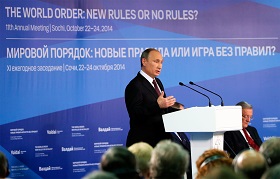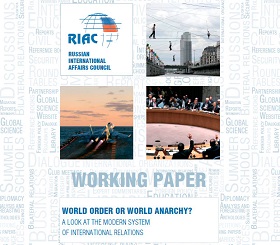The crisis in relations between Russia and the West, the advance of ISIS, and the arms race in the Asia-Pacific region all point to a potential shake-up of the world order. Shake-ups of this kind tend to be of a catastrophic nature – a gradual change in some critical area is suddenly accelerated, triggering a cascade.
Politicians, experts, and decision-makers repeat the mantra of nonlinearity, whereby a butterfly flapping its wings can cause a tsunami on the other side of the world. But their outlook continues to be linear and inertial, regardless. As a result, catastrophes are just that: wholesale, precipitate, destructive events. Nonlinearity has become a cliché, yet few have ever taken the time to ponder the nature of it.
Nonlinearity implies an asymmetric relationship between an outcome and the resources spent on achieving it. In some cases, the effect can be potent, the result poor. In others, even minor factors can produce disastrous consequences. In politics and many other social processes, such asymmetry is determined by resource constraints, since any political process unfolds within limited resource niches, ranging from personnel to finance and technology.
Applying the “predator-prey” model to the system of international relations
The “predator-prey” model is a textbook example of a nonlinear process. There are foxes and rabbits. As long as the rabbit population is large, little effort is required by the foxes to catch them. Neither do they have to compete with each other for prey, since there is plenty. The rabbit population is a resource niche (prey) for the foxes. But there comes a moment when there are too many foxes, and the rabbits’ rate of reproduction fails to keep pace with that of the foxes. Now the foxes have to exert much greater effort to catch their prey. And the result of these efforts is far more modest than before. The reduction in resources leads to competition for prey among the foxes themselves.
Sooner or later, the natural order of predator-prey relations passes a tipping point: either the foxes find new victims (i.e. expand their resource niche) or they kill each other until their dwindling numbers allow the rabbit population to recover. This also addresses the problem of resource constraints, although for the foxes it is more violent and destructive. Moreover, the bloodletting is multiplied by a delay factor inherent in any social or ecological system, whereby the realization that the resources have been replenished, and thus the killing can stop, does not come immediately. In other words, the delay severely exacerbates the competition for resources and its destructive consequences.
This, too, is a manifestation of nonlinearity within a limited resource niche. The scenario can be taken to the extreme: The foxes perish as a result of the resource competition or they destroy all the rabbits. One way or the other, the choice is to find new prey (resource niche) or die of starvation.
In the language of politics, the reduction of resources intensifies the competition for them and leads to a destabilization of the existing order. This destabilization produces qualitative changes (bifurcations) as a result of which either new resource niches appear or competitors are eliminated from the game and their resources are distributed to the winners. Incidentally, the “predator-prey” model is widely used in science to model political and social processes: for example, the relationships between the state and taxpayers, the mafia and business, firms and customers, etc.
International processes are also nonlinear. They clearly develop under resource constraints, and governments endeavor to secure a slice of the pie. This being the case, the resources inevitably decline. And the more the deficit is felt, the more rapidly the world order changes. It can even be said that resource depletion pushes the system of international relations towards anarchy, while resource sufficiency allows a particular order to be built in an atmosphere of cooperation.
There are two solutions for governments to the problem of a deficit: either introduce new technologies to expand the resource niche, or reduce the number of contenders to the existing resource niche. The second solution, in any event, is tactical, since it fails to address the fundamental problem of the limits of growth. Inevitably, the intensity of competition will necessitate a search for new resources. Such process is generally accompanied by a radical shift in the world order. It is clear that governments are unlikely to forgo their share of resources voluntarily, or surrender their position in the world order for the sake of a “bright future.” Therefore, the change is typically characterized by major global shocks – wars, revolutions, failed states and new ones in their place.
Dynamics of the contemporary world order
The Russian International Affairs Council (RIAC) recently prepared a report on the dynamics of the contemporary world order. A feature of the report was the use of nonlinear mathematical models to analyze the dynamics of the parameters of power and the development of modern states.
The report seems to paint a paradoxical picture of the present world order. On the one hand, we observe quite stable dynamics in terms of socio-economic development. In other words, there is yet no shortage of hard resources requiring the conduct of large-scale conflicts and the rearrangement of the existing order by force.
On the other, the world is home to a number of powerful nations whose political relations and security policies could, of their own accord, capsize the world order. Russia is one of these great powers, yet its position in the group looks vulnerable. The conversion of its large political resources into development is bounded. The country’s global weight is highly contingent on its ability to solve internal social and economic problems. In other words, Russia’s success in the international arena does not guarantee its socio-economic development.
The Ukrainian crisis illustrates the situation. Russia took a tough stance, acting ahead of the curve, asserting itself as a world power with a view to be reckoned with. It is now clear that Russia is unlikely to deviate from its chosen course. However, its opponents will respond less by political means, but rather try to limit Russia's access to global sources of growth and development. The pressure will be powerful and concerted, and Russia lacks reliable playing partners. Restricted access to the resources of globalization is the penalty for a tough foreign policy. In the present circumstances, Russia will not be able to assert its political ambitions and still maintain the same level of access to global sources of development.
In this situation, two inauspicious scenarios present themselves.
The first involves a tough confrontation with the West, more consolidated pressure on Russia in the fields of security and economics, marginalization to the world periphery, and severance from financial, technological, and other sources of growth. In this scenario, Russia will find it extremely difficult to survive.
The second entails significant concessions to the West. This is also negative, because in this instance, Russia’s return to the global world would be far more costly. Moreover, the concessions, whatever they may be, are no guarantee that Russia would not be squeezed into a corner or that it would be able to surmount its existing development problems. The bottom line is that both scenarios would deepen Russia’s backwardness and cause serious damage. The world order would be maintained, but without Russia in its accustomed role.
What are Russia’s options?
Naturally, any such scenario is totally unacceptable to Moscow. Hence, Russia is eyeing a possible change in the existing world order. As matters stand, it would suit Russia to realign the world order in such a way as to limit foreign adversaries’ ability to cut it off from the sources of growth. Therein lies the essence of Russian interests in a multipolar world. Multipolarity is the presence of several sources of growth and development, not simply the coexistence of several great powers.
It is evident that Russia is hardly likely to be able to build a world order all on its own. Unlike the Soviet Union, it does not even have a project to propose to other countries. Meanwhile, competition between world order projects is bound to play a part in the future of international relations. Some projects are already familiar, such as the Western liberal approach, involving the preservation and development of the existing model of globalization. Russia’s project will appeal to the costs and excesses of the Western model, and the problems of inequality and resource allocation. It is essentially a “leftist” project, regardless of what name is assigned to it. With the collapse of the Soviet Union, Russia voluntarily relinquished leadership of this project. It cannot reassume it due to a lack of resources and the country’s decisive split from leftist ideas.
So who will lead the global leftist project? The answer is obvious: China.
So far, China has exuded a marked sense of caution and restraint in foreign policy, and has explicitly avoided asserting its global ambitions. But a latent process is underway, and China will one day announce its designs for a new world order. An interesting picture may well soon emerge. Communist China is adapting a number of elements in the economics of capitalism and the tools of democracy – tools, mind you, not principles (the smooth, predictable handover of supreme power combined with flexible regional government).
But internationally it could assert itself in terms of leftist principles – so as to address the problems of marginalization, inequality, distribution of resources, etc. The project will dovetail with Beijing’s official ideology, facilitating its consolidation and legitimization through foreign policy.
The question centers on whether China will, in the foreseeable future, continue to adapt under the Western model or begin to align its own world order. If the confrontation between Russia and the West goes too far, the second option will favor Russia. In such an event, it can try to fit into the Chinese model. But equal status will not be in the cards.
Finally, the last alternative is for Russia to try to keep an independent role in multiple playing fields – not to over-aggravate the confrontation with the West, while avoiding dependence in relations with China, and to stay maneuverable, while solving the problems of its own development. It is essentially a conservative foreign policy model with the same reliance on common sense, pragmatism, and reliance on its own potential. But given Russia’s limited resources and the challenges it faces, it is diplomacy, not military force, which should be the key instrument of foreign policy.
Moscow needs a world order in which none of the players is able to monopolize global sources of growth and cut Russia off from them if political differences arise. Multipolarity is acquiring a conceptually new meaning. Once understood as the coexistence of great powers, it now supposes the presence of several alternative sources of growth and development. One of which, of course, is Russia itself.
Source: Russia Direct.






